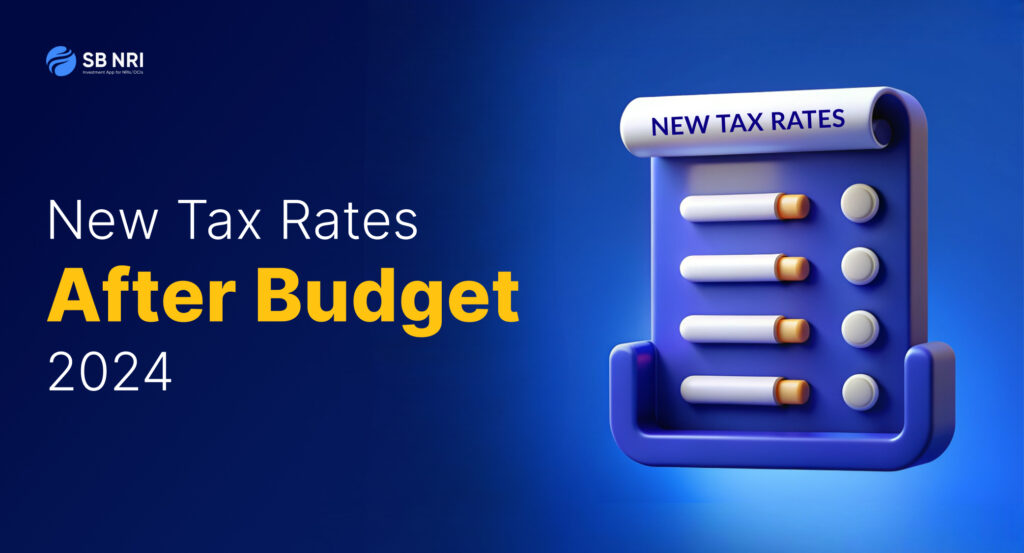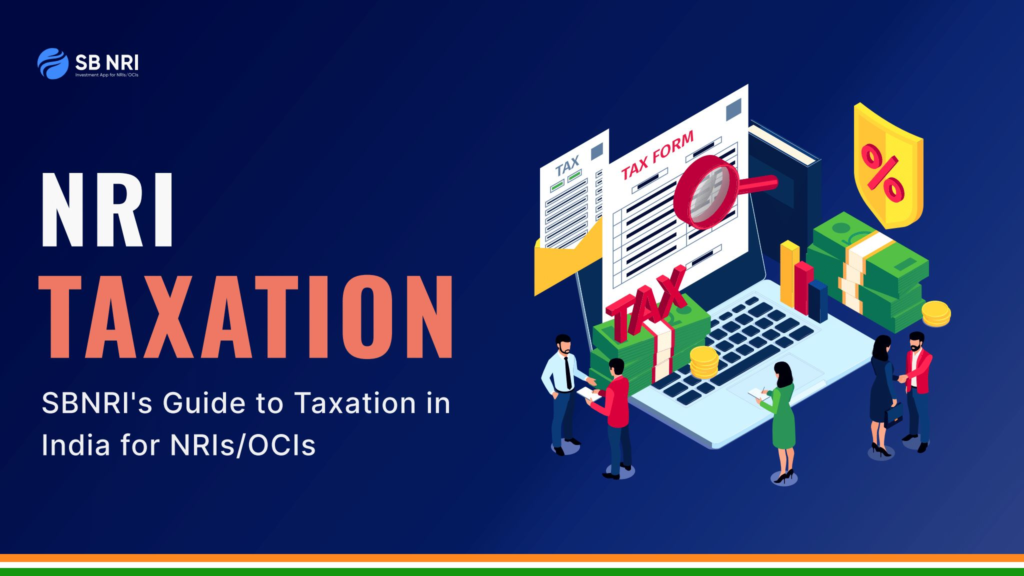
The Union Budget 2024, presented by Finance Minister Nirmala Sitharaman, introduced significant changes in the income tax structure. These changes aim to simplify the tax regime, provide relief to taxpayers, and encourage investment. Here’s a detailed look at the new tax rates and what they mean for residents, Non-Resident Indian(NRI), Overseas Citizen of India(OCI), Hindu Undivided Family (HUFs) and more.
Revised Income Tax Slabs for FY 2024-25
The new income tax slabs for the financial year 2024-25 have been designed to offer more relief to taxpayers, especially those in the middle-income group. FM Nirmala Sitharaman has announced changes in the tax slabs for the new regime. The changes will be applicable for the FY24-25 and will be used to compute Income Tax when filing it next year. The new revised slab rates are:
| Income Tax Slab | New Regime Slab Rates for FY 24-25 (AY 25-26) |
| Up to Rs. 3 lakh | Nil |
| Rs. 3,00,000 -Rs. 7,00,000 | 5% (Rebate u/s 87A available) |
| Rs. 7,00,001 lakh to Rs. 10,00,000 | 10% |
| Rs. 10,00,001 to Rs. 12,00,000 | 15% |
| Rs. 12,00,001 to Rs. 15,00,000 | 20% |
| Above Rs 15,00,000 | 30% |
These revised slabs are part of the new tax regime and will be applicable for the assessment year 2025-26. It is also to note that there have been no changes in the old regime and the slab rates for the old regime will continue as it is.
Also read: NRI Income Tax Slab Rates for FY 2023-24 (AY 2024-25)
Standard Deduction Increased to Rs 75,000
To further ease the tax burden, the standard deduction under the new regime has been increased from Rs. 50,000 to Rs. 75,000. This adjustment ensures that individuals with an income up to Rs. 7.75 lakhs will not have to pay any tax after accounting for the Section 87A rebate and the standard deduction.
Also read: Budget 2024 Highlights: Key Takeaways & Sectors to Watch Post-Budget
Long-Term Capital Gains (LTCG)
Significant changes have been made to the taxation of long-term capital gains:
- The LTCG limit has been increased from Rs. 1 lakh to Rs. 1.25 lakh per year.
- The LTCG tax rate has been revised from 10% to 12.5%.
This move aims to provide relief to investors and reduce their tax liabilities on long-term investments.
Also read: ITR Filing for NRIs AY 2024-25: Step-by-Step ITR Filing Process
Abolition of Angel Tax
One of the noteworthy changes in the Budget 2024 is the abolition of Angel Tax across all categories of taxpayers. This decision is expected to boost startup investments and foster innovation in the country.
Also read: Penalty for Non-filing of ITR by Due Date: Know all the Rules
Removal of TDS on Mutual Fund Withdrawals
Previously, a 20% TDS was levied on the repurchase of mutual fund units by the fund itself. The Budget 2024 has removed this TDS, making it easier for investors to manage their funds and encouraging more participation in mutual fund investments.
Also read: New Rules for NRI Taxation in India FY-2023-24
Implications of the New Tax Rates
The new tax rates and provisions are designed to:
- Provide greater relief to taxpayers, especially in the middle-income bracket.
- Simplifying the tax structure makes it easier for individuals to understand and comply with.
- Encourage investments by providing favorable conditions for long-term capital gains and mutual fund withdrawals.
- Support startups and innovation by abolishing Angel Tax.
Also Read: 5 Ways to save on the tax NRIs have to pay
When do Budget Tax changes take effect?
The changes in tax rates and other tax-related provisions announced in the Union Budget typically take effect from the start of the new financial year, which is April 1st. This means that the new tax rates, revised deductions, and other changes will apply to the income earned from April 1st of the current year to March 31st of the following year. For instance, the changes announced in the Budget 2024 will be applicable for the financial year 2024-25, and individuals will see these changes reflected when filing their income tax returns in the assessment year 2025-26.
Wrapping Up
The Budget 2024 brings significant changes to the tax landscape in India. With revised income tax slabs, increased standard deductions, and favorable investment provisions, the new tax regime aims to ease the burden on taxpayers while promoting economic growth. Taxpayers should review these changes carefully and plan their finances accordingly to maximize the benefits.
Access SBNRI’s Exclusive NRI Taxation Guide

NRIs and OCIs can now access SBNRI’s exclusive NRI Taxation Guide covering in-depth information about DTAA, Gift Tax, Rental Income Tax, ITR Filing, Types of ITR Forms for NRIs, Capital Gain Tax, Income Tax, and more. The report will help you understand India taxation on mutual funds, other asset classes and how you can comply with the regulations.
Access NRI Taxation Guide here
Calculate your TDS Refund with SBNRI’s TDS Refund Calculator
A TDS refund is the process of reclaiming the excess tax deducted at source by the payer if the actual tax liability of the taxpayer is lower than the TDS deducted. This situation typically arises when the income tax calculated on the total income is less than the TDS already deducted. To claim a TDS refund, taxpayers need to file an income tax return (ITR). The Income Tax Department processes the ITR and verifies the details. If the tax department finds that the TDS paid is more than the actual tax liability, the excess amount is refunded to the taxpayer.
You can easily find out how much tax refund you can get by calculating your TDS Refund from this TDS Refund Calculator.
Looking for NRI ITR Filing? Connect with SBNRI NRI Tax Expert CA Today!

At SBNRI, we have simplified ITR filing for NRIs/OCIs through a smooth digital journey. Be it Basic Filing, Advanced Filing (includes Capital Gain, etc.), or Premium Filing (Foreign Income), we can help you assess the right computation and lower your tax liability.
“We’ve helped over 500+ NRIs/OCIs file ITR returns and more than 25,000+ across other taxation services last financial year and we’d love to help you out too”
You can download SBNRI App or connect with NRI Tax Expert team directly via the button below.
FAQs
What are the new income tax slab rates for FY 2023-24 under the new regime?
The new regime slabs are as follows:
- Up to Rs 3 lakh: Nil
- Rs 3 lakh – 6 lakh: 5%
- Rs 6 lakh – 9 lakh: 10%
- Rs 9 lakh – 12 lakh: 15%
- Rs 12 lakh – 15 lakh: 20%
- Above Rs 15 lakh: 30%
What changes have been made to the standard deduction under the new regime?
The standard deduction amount has been increased from Rs 50,000 to Rs 75,000 under the new regime.
What is the new Long Term Capital Gains (LTCG) tax rate?
The LTCG tax rate has been revised to 12.5%, and the LTCG limit has been increased to Rs 1.25 lakh per year from Rs 1 lakh.
Is Angel Tax still applicable?
No, Angel Tax has been abolished across all categories of taxpayers.
What are the revised tax slab rates under the old regime?
The old regime rates remain unchanged:
- Up to Rs 2.5 lakh: Nil
- Rs 2.5 lakh – 5 lakh: 5%
- Rs 5 lakh – 10 lakh: 20%
- Above Rs 10 lakh: 30%
Has there been any change to TDS on mutual fund withdrawals?
Yes, TDS on mutual fund withdrawals has been removed. Previously, it was 20% on repurchases by mutual funds or UTI.
What is the surcharge on high-income earners under the new regime?
The surcharge rates are:
- 10% for income > Rs 50 lakh up to Rs 1 crore
- 15% for income > Rs 1 crore up to Rs 2 crore
- 25% for income > Rs 2 crore up to Rs 5 crore
- 37% for income > Rs 5 crore
What is the tax rebate available under Section 87A?
Under the new regime, individuals with a net taxable income up to Rs 7 lakh will get a full tax rebate under Section 87A, resulting in zero tax liability.
Are senior citizens and super senior citizens subject to the same tax rates in the new regime?
Yes, the new tax regime applies the same rates for all individuals, including senior and super-senior citizens.
Can individuals still claim deductions under Section 80C in the new regime?
No, most deductions, including those under Section 80C, are not available in the new tax regime. This regime is designed to be simpler but does not allow for common deductions and exemptions. You can read more about deductions under new regime here.



